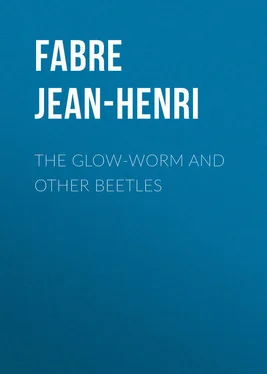Jean-Henri Fabre - The Glow-Worm and Other Beetles
Здесь есть возможность читать онлайн «Jean-Henri Fabre - The Glow-Worm and Other Beetles» — ознакомительный отрывок электронной книги совершенно бесплатно, а после прочтения отрывка купить полную версию. В некоторых случаях можно слушать аудио, скачать через торрент в формате fb2 и присутствует краткое содержание. Жанр: foreign_antique, foreign_prose, на английском языке. Описание произведения, (предисловие) а так же отзывы посетителей доступны на портале библиотеки ЛибКат.
- Название:The Glow-Worm and Other Beetles
- Автор:
- Жанр:
- Год:неизвестен
- ISBN:нет данных
- Рейтинг книги:5 / 5. Голосов: 1
-
Избранное:Добавить в избранное
- Отзывы:
-
Ваша оценка:
- 100
- 1
- 2
- 3
- 4
- 5
The Glow-Worm and Other Beetles: краткое содержание, описание и аннотация
Предлагаем к чтению аннотацию, описание, краткое содержание или предисловие (зависит от того, что написал сам автор книги «The Glow-Worm and Other Beetles»). Если вы не нашли необходимую информацию о книге — напишите в комментариях, мы постараемся отыскать её.
The Glow-Worm and Other Beetles — читать онлайн ознакомительный отрывок
Ниже представлен текст книги, разбитый по страницам. Система сохранения места последней прочитанной страницы, позволяет с удобством читать онлайн бесплатно книгу «The Glow-Worm and Other Beetles», без необходимости каждый раз заново искать на чём Вы остановились. Поставьте закладку, и сможете в любой момент перейти на страницу, на которой закончили чтение.
Интервал:
Закладка:
For that matter, it is easy to convince ourselves that the egg combines with the function of a life-buoy that of the first ration. I have laid on the surface of the honey in a cell a tiny strip of paper, of the same dimensions as the egg; and on this raft I have placed a Sitaris-larva. Despite every care, my attempts, many times repeated, always failed. The larva, placed in a paper boat in the centre of the mass of honey, behaves as in the earlier experiments. Not finding what suits it, it tries to escape and perishes in the sticky toils as soon as it leaves the strip of paper, which it soon does.
On the other hand, we can easily rear Sitaris-grubs by taking Anthophora-cells not invaded by the parasites, cells in which the egg is not yet hatched. All that we have to do is to pick up one of these grubs with the moistened tip of a needle and to lay it delicately on the egg. There is then no longer the least attempt to escape. After exploring the egg to find its way about, the larva rips it open and for several days does not stir from the spot. Henceforth its development takes place unhindered, provided that the cell be protected from too rapid evaporation, which would dry up the honey and render it unfit for the grub's food. The Anthophora's egg therefore is absolutely necessary to the Sitaris-larva, not merely as a boat, but also as its first nourishment. This is the whole secret, for lack of knowing which I had hitherto failed in my attempts to rear the larvæ hatched in my glass jars.
At the end of a week, the egg, drained by the parasite, is nothing but a dry skin. The first meal is finished. The Sitaris-larva, whose dimensions have almost doubled, now splits open along the back; and through a slit which comprises the head and the three thoracic segments a white corpusculum, the second form of this singular organism, escapes to fall on the surface of the honey, while the abandoned slough remains clinging to the raft which has hitherto safeguarded and fed the larva. Presently both sloughs, those of the Sitaris and the egg, will disappear, submerged under the waves of honey which the new larva is about to raise. Here ends the history of the first form adopted by the Sitaris.
In summing up the above, we see that the strange little creature awaits, without food, for seven months, the appearance of the Anthophoræ and at last fastens on to the hairs on the corselet of the males, who are the first to emerge and who inevitably pass within its reach in going through their corridors. From the fleece of the male the larva moves, three or four weeks later, to that of the female, at the moment of coupling; and then from the female to the egg leaving the oviduct. It is by this concatenation of complex manoeuvres that the larva in the end finds itself perched upon an egg in the middle of a closed cell filled with honey. These perilous gymnastics on the hair of a Bee in movement all the day, this passing from one sex to the other, this arrival in the middle of the cell by way of the egg, a dangerous bridge thrown across the sticky abyss, all this necessitates the balancing-appliances with which it is provided and which I have described above. Lastly, the destruction of the egg calls, in its turn, for a sharp pair of scissors; and such is the object of the keen, curved mandibles. Thus the primary form of the Sitares has as its function to get itself carried by the Anthophora into the cell and to rip up her egg. This done, the organism becomes transformed to such a degree that repeated observations are required to make us believe the evidence of our eyes.
CHAPTER IV
THE PRIMARY LARVA OF THE OIL-BEETLES
I interrupt the history of the Sitares to speak of the Meloes, those uncouth Beetles, with their clumsy belly and their limp wing-cases yawning over their back like the tails of a fat man's coat that is far too tight for its wearer. The insect is ugly in colouring, which is black, with an occasional blue gleam, and uglier still in shape and gait; and its disgusting method of defence increases the repugnance with which it inspires us. If it judges itself to be in danger, the Meloe resorts to spontaneous bleeding. From its joints a yellowish, oily fluid oozes, which stains your fingers and makes them stink. This is the creature's blood. The English, because of its trick of discharging oily blood when on the defensive, call this insect the Oil-beetle. It would not be a particularly interesting Beetle save for its metamorphoses and the peregrinations of its larva, which are similar in every respect to those of the larva of the Sitares. In their first form, the Oil-beetles are parasites of the Anthophoræ; their tiny grub, when it leaves the egg, has itself carried into the cell by the Bee whose victuals are to form its food.
Observed in the down of various Bees, the queer little creature for a long time baffled the sagacity of the naturalists, who, mistaking its true origin, made it a species of a special family of wingless insects. It was the Bee-louse ( Pediculus apis ) of Linnæus; 17 17 Carolus Linnæus (Karl von Linné, 1707-1778), the celebrated Swedish botanist and naturalist, founder of the Linnæan system of classification. — Translator's Note .
the Triungulin of the Andrenæ ( Triungulinus andrenetarum ) of Léon Dufour. They saw in it a parasite, a sort of Louse, living in the fleece of the honey-gatherers. It was reserved for the distinguished English naturalist Newport to show that this supposed Louse was the first state of the Oil-beetles. Some observations of my own will fill a few lacunæ in the English scientist's monograph. I will therefore sketch the evolution of the Oil-beetles, using Newport's work where my own observations are defective. In this way the Sitares and the Meloes, alike in habits and transformations, will be compared; and the comparison will throw a certain light upon the strange metamorphoses of these insects.
The same Mason-bee ( Anthophora pilipes ) upon whom the Sitares live also feeds a few scarce Meloes ( M. cicatricosus ) in its cells. A second Anthophora of my district ( A. parietina ) is more subject to this parasite's invasions. It was also in the nests of an Anthophora, but of a different species ( A. retusa ), that Newport observed the same Oil-beetle. These three lodgings adopted by Meloe cicatricosus may be of some slight interest, as leading us to suspect that each species of Meloe is apparently the parasite of diverse Bees, a suspicion which will be confirmed when we examine the manner in which the larvæ reach the cell full of honey. The Sitares, though less given to change of lodging, are likewise able to inhabit nests of different species. They are very common in the cells of Anthophora pilipes; but I have found them also, in very small numbers, it is true, in the cells of A. personata .
Despite the presence of Meloe cicatricosus in the dwellings of the Mason-bee, which I so often ransacked in compiling the history of the Sitares, I never saw this insect, at any season of the year, wandering on the perpendicular soil, at the entrance of the corridors, for the purpose of laying its eggs there, as the Sitares do; and I should know nothing of the details of the egg-laying if Godart, 18 18 Jean Baptiste Godart (1775-1823), the principal editor of L'Histoire naturelle des lépidoptères de France . — Translator's Note .
de Geer 19 19 Baron Karl de Geer (1720-1778), the Swedish entomologist, author of Mémoires pour servir à l'histoire des insectes (1752-1778). — Translator's Note .
and, above all, Newport had not informed us that the Oil-beetles lay their eggs in the earth. According to the last-named author, the various Oil-beetles whom he had the opportunity of observing dig, among the roots of a clump of grass, in a dry soil exposed to the sun, a hole a couple of inches deep which they carefully fill up after laying their eggs there in a heap. This laying is repeated three or four times over, at intervals of a few days during the same season. For each batch of eggs the female digs a special hole, which she does not fail to fill up afterwards. This takes place in April and May.
Интервал:
Закладка:
Похожие книги на «The Glow-Worm and Other Beetles»
Представляем Вашему вниманию похожие книги на «The Glow-Worm and Other Beetles» списком для выбора. Мы отобрали схожую по названию и смыслу литературу в надежде предоставить читателям больше вариантов отыскать новые, интересные, ещё непрочитанные произведения.
Обсуждение, отзывы о книге «The Glow-Worm and Other Beetles» и просто собственные мнения читателей. Оставьте ваши комментарии, напишите, что Вы думаете о произведении, его смысле или главных героях. Укажите что конкретно понравилось, а что нет, и почему Вы так считаете.












